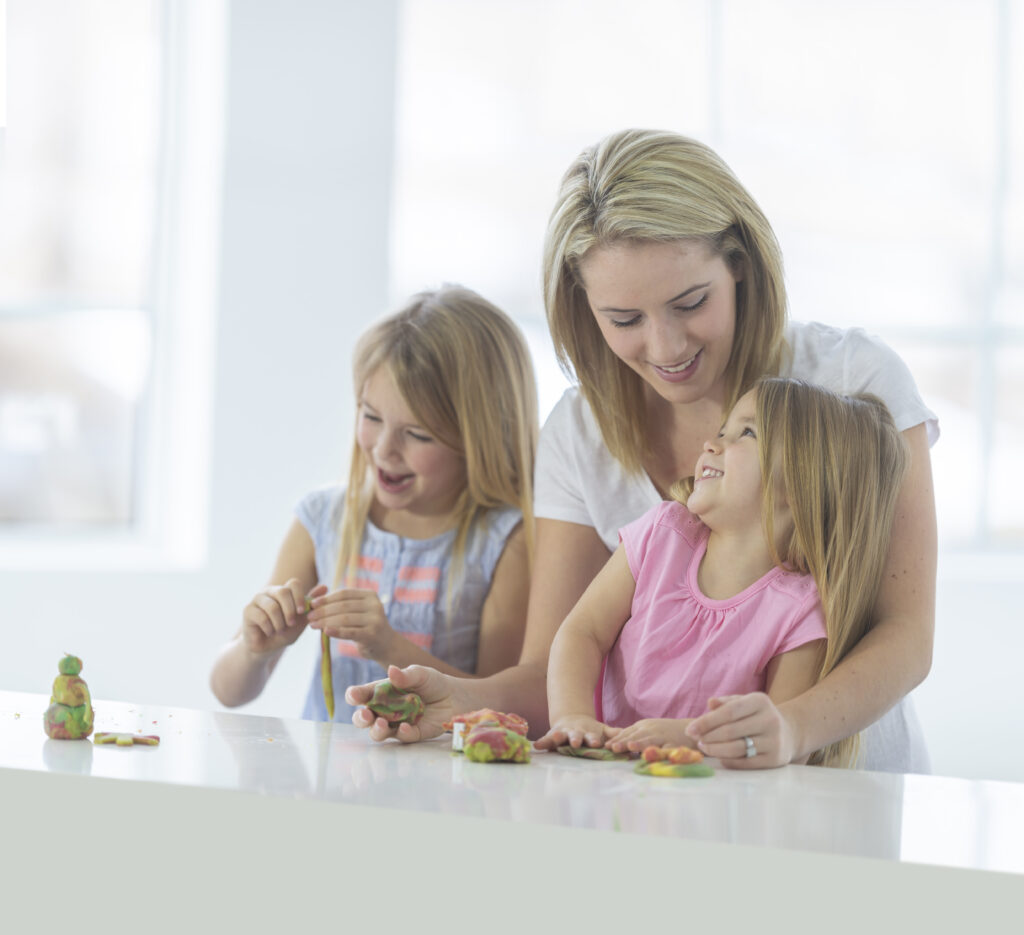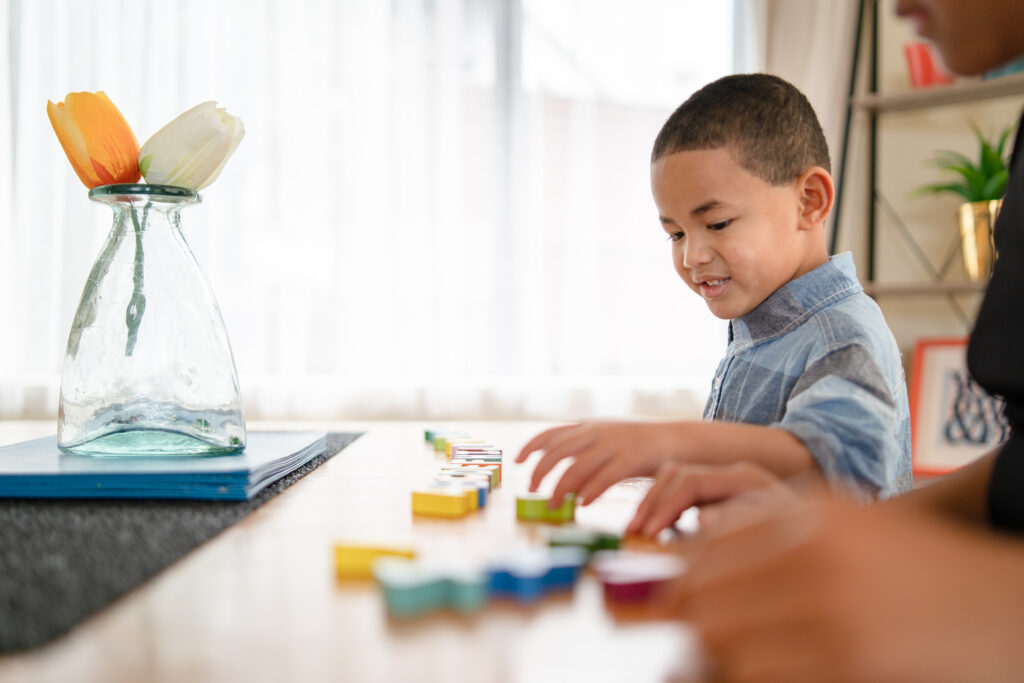Playdough is a childhood staple and can keep children busy for hours as they use their imagination. Using playdough is a fun pastime that children of varying ages can enjoy in numerous ways. Let’s discuss the developmental benefits of playdough at a young age.
What playdough teaches children
Playing with playdough at home or school promotes learning and early childhood development. Children experiment with playdough to generate ideas, satisfy curiosity and examine and solve issues. Children develop their imagination when playing with playdough. As a child works with playdough, they develop skills needed for later skills and school readiness.
Instead of letting children watch TV all day, give them playdough and encourage them to spend time away from the screen. Playing with playdough helps them slow down and pay attention to what they are doing—and keeps children occupied as they use their senses and skills while they’re busy rolling and playing.
What skills does playdough develop in early childhood?
Fine motor skills
Before children can learn to write at school, they need to build their finger muscles and learn how to control these little muscles. During preschool, they play in different ways that help them build those muscles. One of the benefits of playdough is improving their fine motor development and pincer grasp, which happens when children shape, flatten, squeeze, pinch, break and roll playdough.
Give children more tools to play with, like cutters, plastic knives and rolling pins, and ask them to add things to their projects, like beads, buttons and shells. These tools will help them improve their physical and fine motor development even more.
Creativity
Watch children be creative as they play with playdough. Younger children often start making simple things like worms, pancakes, pizzas and balls. As they get older, a child’s imagination widens, and their playdough creations tend to become much more complicated. Children use symbolic thinking and pretend that the playdough is something else, like a birthday cake. When using playdough with friends, the creations can even have many more different characters and structures. This imaginative play is essential for children’s cognitive flexibility and communication skills.

Hand-eye coordination
Children also learn hand-eye coordination by using their hands to shape playdough as they are intentionally looking and manipulating at the same time. Some actions that children can do when shaping playdough that improve hand-eye coordination are:
- Pulling, squeezing and squishing playdough
- Pounding or hammering—flattening a ball of playdough with either hands or both hands
- Rolling—make balls, spaghetti, sausages, worms/snakes or balls
- Chopping and cutting
Literacy and numeracy
Younger children begin to familiarise themselves with different letters and numbers as they progress through different learning styles. As they are shaping playdough, they can do several exercises that involve playing with it.
For numeracy, you can ask a child to roll ten balls, add two sticks, construct a 3D shape or practise adding and subtracting. A child can even spell their name using playdough or count out rolled balls to match numbered flash cards. The ideas children can develop are limited only by their creativity.
Speech and language
Playdough play helps improve a child’s speech and language abilities as they learn new words about new concepts. They can describe the texture to their teacher and connect simple ideas to new vocabulary terms.
Children playing with different materials will come across words such as chop, roll, flatten or rolling pin. And as they chat with their peers, they naturally improve their literacy and reap the benefits of interacting with others.
Critical thinking
A child’s development can be challenging, especially when they need to apply critical thinking in their play. But when children play with playdough, they can do whatever they want—deciding what they want to learn and how they want to learn it. Many problems can only be solved by thinking outside the box. Playing with playdough allows children to try things out, find solutions and make mistakes.

What are the other benefits of playdough in early learning?
Therapeutic and calming
Playdough can help children shift from loud play to quiet time and relaxation. Its texture, which is soft and spongy, is very therapeutic, soothing and relaxing.
It reduces stress and helps anxious children, as playing with playdough is soothing. The gooey mix transforms with more flour and is used in most early childhood education settings. You can also add essential oils such as lavender, eucalyptus or other scents to playdough or use cool colours to make playdough more relaxing.
Sensory learning experiences
Playing with playdough can cause good sensory overload! There are so many things to look at, touch and smell. You can add essential oils, but even the salty smell itself can be enticing to young children.
There are many different touch experiences with playdough, especially when combined with other items or ornaments.
Some children will even try to eat their playdough! Although small amounts won’t hurt them too much, you should still stop them from trying to eat it.
Cognitive development
Using playdough helps with decision making based on what children think about a situation. Teachers can ask questions like, “What did you make with the playdough?” By asking the child open-ended questions, the teacher helps the child use their imagination and cognitive skills to come up with answers.
Children will talk about what they made and why they made it. Each of them uses their intelligence, language and communication skills to understand and to be understood. There’s no right or wrong way to play, allowing self-esteem to develop during play.
Social development
One of the more significant ways that playing with playdough increases children’s learning opportunities is by offering them the chance to practise their social skills. It keeps children busy while they learn pre-writing skills.
Most of the time, children play with playdough together, and then discuss what they did and share their ideas in the childcare centre. They get to play fun games about stories, which helps them learn more about the real world and how children should interact with each other.
Children can make each other gifts or create things together with the same theme.
Promotes playtime
In today’s technology-driven environment, children are always drawn to the newest toy or piece of electronic equipment. Instead of allowing your children to spend the entire day in front of the television, give them playdough and encourage them to spend time alone.
One of the benefits of playdough is that it encourages children to take their time and concentrate on the activity of playing while also engaging their senses and developing various skills.
Playdough activity ideas
Gingerbread playdough
Start with a no-cook, easy playdough recipe and add gingerbread spices. You can experiment with the quantities of spices when making playdough. Using the gingerbread playdough, give children gingerbread cookie cutters! The playdough will naturally become a rich brown without needing food colouring, and it smells good enough to eat—just make sure the children don’t actually eat it!

Ornaments
Using other elements with playdough gives children opportunities to explore ideas. Loose parts or ornaments can increase creativity and provide a multi-sensory experience. Some examples of ornaments and tools that can be used are:
- Objects from nature—stones, sticks, pebbles, pine cones, bark, shells and leaves
- Things from the classroom—wooden letters and wooden blocks
- Ornaments for creating characters—googly eyes, sequins, buttons, cloth, nets and ribbons
- Items from the kitchen—coloured rice, dry pasta, drinking straws, lids, cake cases, cookie cutters, egg cartons and muffin tins
Lego playdough
Another fun thing to do is to build pictures out of playdough. Simply roll out a piece of playdough into a thin layer like a blank canvas, and then press Lego bricks into it. Children can form images, designs or abstract artwork. You can also ask children to cut the playdough into different shapes before putting it in Lego bricks.
You can also experiment with both sides of the Lego, taking advantage of the varying sizes and shapes. Take pictures of their playdough creations and store them digitally so you can remind children of them later.
When children are done with their playdough creations, don’t forget to document them with a teacher app, like Playground, to add to learning stories and share with parents.

